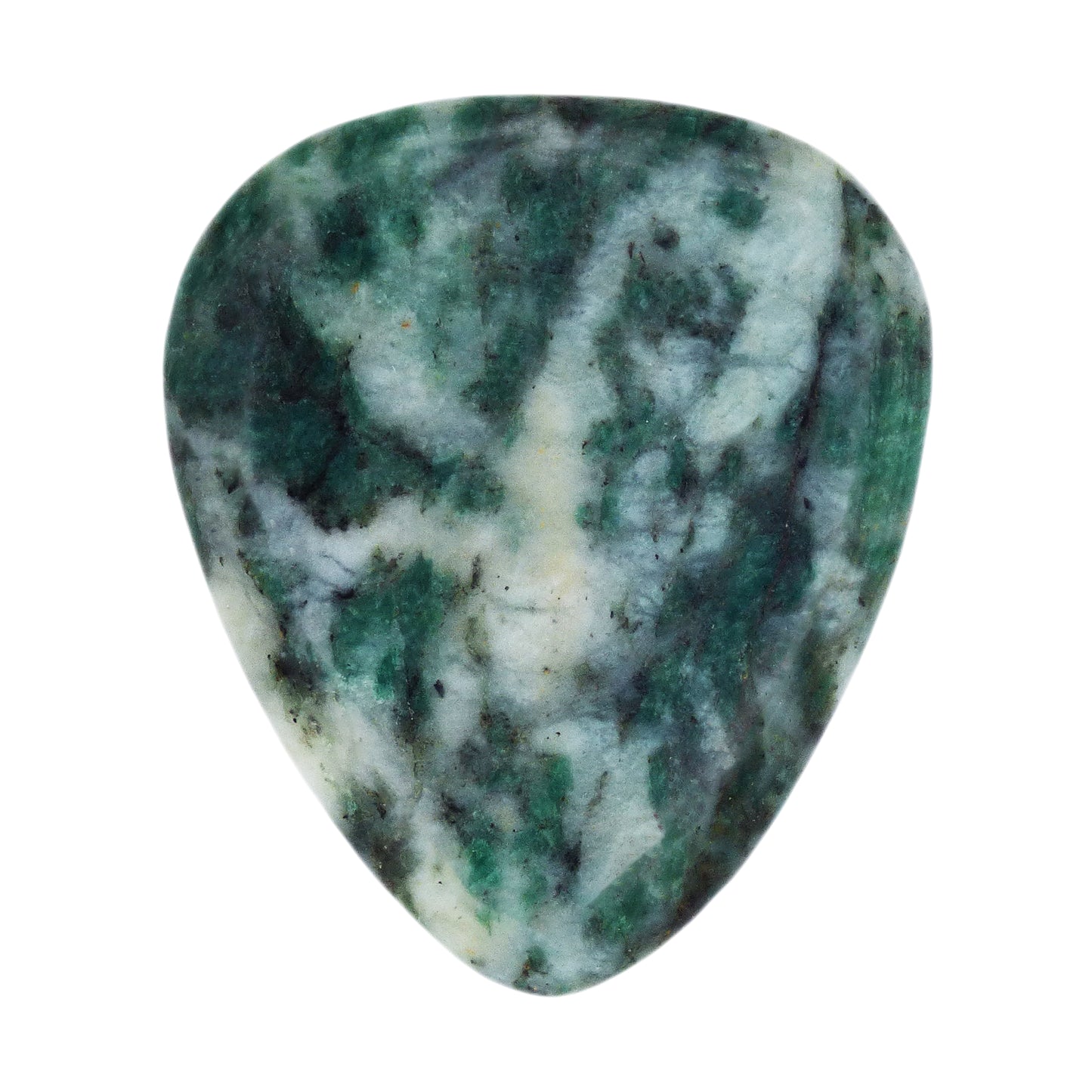Qinghai Kunlun Jade Stone Guitar Or Bass Pick - 3.0 mm Ultra Heavy Gauge - 351 Shape - Specialty Handmade Gemstone Exotic Plectrum
Qinghai Kunlun Jade Stone Guitar Or Bass Pick - 3.0 mm Ultra Heavy Gauge - 351 Shape - Specialty Handmade Gemstone Exotic Plectrum
Regular price
$7.99 USD
Regular price
$15.99 USD
Sale price
$7.99 USD
Unit price
per
Shipping calculated at checkout.
Couldn't load pickup availability
Qinghai Kunlun Jade Stone Guitar Or Bass Pick - 3.0 mm Ultra Heavy Gauge - 351 Shape - Specialty Handmade Exotic Gemstone Plectrum
These exotic handmade Qinghai Kunlun Jade plectrums sound great for acoustic or electric guitar players, bass, ukulele and semi hollow body jazz guitarists due to their unique and clean tonal color production.
These picks are in a polished finish and have a very attractive aesthetic and natural beauty. Because these are a handcrafted product each one is unique and the inherent colors and patterns present in each individual stone will vary in appearance, as well as slightly in size and thickness. These plectrums are a very thick heavy gauge and measure approximately 3.0mm in thickness.
Start exploring new tones with these exotic Qinghai Kunlun Jade picks today because the simplest and most inexpensive way to change your tone is to change your pick.
Specifications:
• Thickness: 3.0 mm
• Color: Qinghai Kunlun Jade
• Material: Qinghai Kunlun Jade
• Size: 30mm x 25 mm x 3.0 mm
• Shape: Standard 351 pick shape
• Blank guitar picks, no printing or logo
About The Material These Picks Are Made From:
Plectrums made from stone have been used traditionally throughout the world since the dawn of stringed instruments millennia ago. Jade is one of the most classic and prized ornamental stones in the world, and Qinghai Jade from the Kunlun mountains in China is one of the most admired types of Jade.
Jade has been used by many cultures around the world since ancient times, and has been valued for its practical uses, aesthetic qualities, as well as its healing and metaphysical properties for thousands of years. Jade is one of the most revered stones in Asia, and has seen widespread use in China, Japan, Korea, India, and most other parts of the continent. In China Jade was thought of as the "Imperial Gem" and considered especially important and regal, on par with the importance of gold or diamonds in the western world. To this day Jade is the national stone of Japan. It was also mined and used throughout the islands of the South Pacific by peoples as far south as the Maori in New Zealand. In Mesoamerica cultures such as the Olmecs, Maya, Aztecs, and others all considered it one of the most valuable ornamental stones due to its rarity in the region. While it was not common in western Asia or Europe in ancient times, once exposed to its elegance Europeans and others quickly came to appreciate it as much as cultures from the east.
Jade is typically thought of as being green as many of the most commonly used and cherished varieties are predominantly green, however Jade actually comes in a wide range of colors including white, black, yellow, orange, pink, brown, and types that feature more than one color in the same stone. Within these color ranges the specific hue can vary significantly from ultra dark to very pale, and Jade can be completely opaque or highly translucent.
In common use Jade typically refers to one of two different types of minerals, Nephrite which is a silicate of calcium and magnesium, or Jadeite which is a silicate of sodium and aluminum. Historically they were both simply called Jade, but in 1863 a French mineralogist named Alexis Damour discovered that different varieties had different compositions and split Jade into the two scientific names used today. In practical terms their physical properties are very similar as are the aesthetics. Jadeite is slightly harder with a Mohs hardness rating between 6.0 and 7.0, vs Nephrite at 6.0 to 6.5, however Nephrite is somewhat more resistant to breakage.
Jade has held a variety metaphysical and supernatural meanings to different cultures throughout history. A round Jade disk with a hole in the center symbolizes heaven in China, in Japan green Jade symbolizes fertility, and in Mesoamerica it was thought to have healing powers. Jade has traditionally been used to make a wide variety of items such as beads, pendants, statuettes, cups, bowls, knives, and even burial suits for the Chinese Imperial family. Ancient artifacts made of Jade are some of the finest works of art humanity has ever fashioned.
The Kunlun mountains in China are famous for several types of fine Jade, and this multicolored variety from the Qinghai province is one of the most popular and visually appealing. Qinghai Jade is known for its green and white coloration which can sometimes feature hints of blacks or browns in it. The colors and patterns in Qinghai Kunlun Jade can vary widely, but no matter the color combination Qinghai Kunlun Jade is always a stunning looking stone.
Qinghai Kunlun Jade is a hard and durable stone, with a 6-6.5 rating on the Mohs hardness scale, which makes it a fantastic and long lasting material for use in guitar picks.
These exotic handmade Qinghai Kunlun Jade plectrums sound great for acoustic or electric guitar players, bass, ukulele and semi hollow body jazz guitarists due to their unique and clean tonal color production.
These picks are in a polished finish and have a very attractive aesthetic and natural beauty. Because these are a handcrafted product each one is unique and the inherent colors and patterns present in each individual stone will vary in appearance, as well as slightly in size and thickness. These plectrums are a very thick heavy gauge and measure approximately 3.0mm in thickness.
Start exploring new tones with these exotic Qinghai Kunlun Jade picks today because the simplest and most inexpensive way to change your tone is to change your pick.
Specifications:
• Thickness: 3.0 mm
• Color: Qinghai Kunlun Jade
• Material: Qinghai Kunlun Jade
• Size: 30mm x 25 mm x 3.0 mm
• Shape: Standard 351 pick shape
• Blank guitar picks, no printing or logo
About The Material These Picks Are Made From:
Plectrums made from stone have been used traditionally throughout the world since the dawn of stringed instruments millennia ago. Jade is one of the most classic and prized ornamental stones in the world, and Qinghai Jade from the Kunlun mountains in China is one of the most admired types of Jade.
Jade has been used by many cultures around the world since ancient times, and has been valued for its practical uses, aesthetic qualities, as well as its healing and metaphysical properties for thousands of years. Jade is one of the most revered stones in Asia, and has seen widespread use in China, Japan, Korea, India, and most other parts of the continent. In China Jade was thought of as the "Imperial Gem" and considered especially important and regal, on par with the importance of gold or diamonds in the western world. To this day Jade is the national stone of Japan. It was also mined and used throughout the islands of the South Pacific by peoples as far south as the Maori in New Zealand. In Mesoamerica cultures such as the Olmecs, Maya, Aztecs, and others all considered it one of the most valuable ornamental stones due to its rarity in the region. While it was not common in western Asia or Europe in ancient times, once exposed to its elegance Europeans and others quickly came to appreciate it as much as cultures from the east.
Jade is typically thought of as being green as many of the most commonly used and cherished varieties are predominantly green, however Jade actually comes in a wide range of colors including white, black, yellow, orange, pink, brown, and types that feature more than one color in the same stone. Within these color ranges the specific hue can vary significantly from ultra dark to very pale, and Jade can be completely opaque or highly translucent.
In common use Jade typically refers to one of two different types of minerals, Nephrite which is a silicate of calcium and magnesium, or Jadeite which is a silicate of sodium and aluminum. Historically they were both simply called Jade, but in 1863 a French mineralogist named Alexis Damour discovered that different varieties had different compositions and split Jade into the two scientific names used today. In practical terms their physical properties are very similar as are the aesthetics. Jadeite is slightly harder with a Mohs hardness rating between 6.0 and 7.0, vs Nephrite at 6.0 to 6.5, however Nephrite is somewhat more resistant to breakage.
Jade has held a variety metaphysical and supernatural meanings to different cultures throughout history. A round Jade disk with a hole in the center symbolizes heaven in China, in Japan green Jade symbolizes fertility, and in Mesoamerica it was thought to have healing powers. Jade has traditionally been used to make a wide variety of items such as beads, pendants, statuettes, cups, bowls, knives, and even burial suits for the Chinese Imperial family. Ancient artifacts made of Jade are some of the finest works of art humanity has ever fashioned.
The Kunlun mountains in China are famous for several types of fine Jade, and this multicolored variety from the Qinghai province is one of the most popular and visually appealing. Qinghai Jade is known for its green and white coloration which can sometimes feature hints of blacks or browns in it. The colors and patterns in Qinghai Kunlun Jade can vary widely, but no matter the color combination Qinghai Kunlun Jade is always a stunning looking stone.
Qinghai Kunlun Jade is a hard and durable stone, with a 6-6.5 rating on the Mohs hardness scale, which makes it a fantastic and long lasting material for use in guitar picks.


